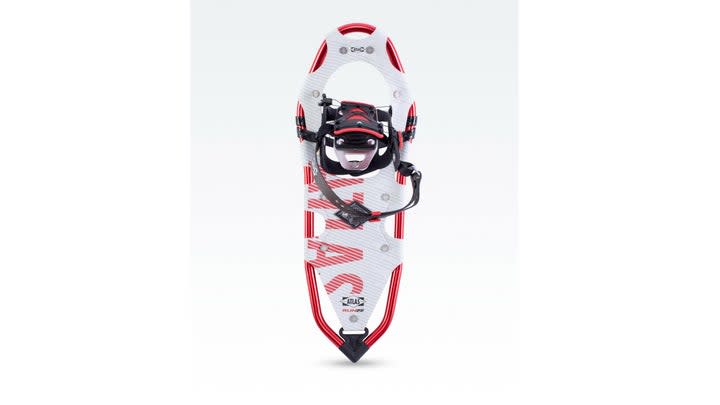What Do I Need For Running In Tough Winter Conditions?

[ad_1]
This article originally appeared on Triathlete
Ok, I’ll preface this week’s column by calling out the elephant in the room: Yes, I currently live in Southern California, where even the thought of temperatures under 50 degrees F shuts down an entire city and sends arctic-level Patagonia puffy sales through the roof. But, before that, I spent four long, grueling years running collegiately in Central Pennsylvania–a place known for conditions more akin to Minnesota winters than what you’d find in the mid-Atlantic. Maybe it has to do with being on the colder Northwestern edge of the Appalachian Mountains; maybe it’s just some ironic joke played on those who go to school in a place called Happy Valley. For sure there are colder places in the U.S., but tell that to one of my former college teammates who had a piece of her ear break off due to running in extreme winter conditions. A. Piece. Of. Her. Ear.
Graphic appendage anecdotes aside, you learn a little bit about running in horrifying conditions when you have literally no choice year round, for six days a week, for four cold, miserable years straight. (Did I mention I live in Southern California now?) Yes, clothing is essential, but you need more than a warm jacket for a productive run in the winter and early spring. We’ll start with a few quick tips and big reasons why you should even set foot outside when conditions are Central-PA-esque, then dive into a handful of very important bits of gear you’ll need to squeeze the most out of winter running (and keep your ears on your head, where they belong).
Running In Tough Winter Conditions: Why?
Treadmills exist, right? Yes, but while there are some intrinsic benefits to running on a treadmill (not getting cold/sick, not dealing with cold/tight muscles, working on turnover, watching all of Netflix, etc.), there are also reasons to run outside–even if it’s terrible out. Aside from the whole toughness/grit factor, running on unstable surfaces and up hills, and maintaining your “outside stride” are all big reasons to mix it up by taking a time out from the treadmill. Running only on treadmills can work very specific muscles in very specific (and linear) ways–and unless you have a very very nice treadmill, it’ll rarely replicate the way you really run when you’re on the roads and trails. Furthermore, running in the snow and muck can actually help work lots of stability muscles that would otherwise go entirely unused in the all-important winter build phase of your training, leaving you open for injury when you head outside and ramp up the intensity. (Rocky didn’t just pull sleds in the snow for the hell of it!) Also, there’s nothing better than the humblebrag social post about running in sub 20-degree weather while everyone else is hiding inside.
Running In Tough Winter Conditions: Dressing The Part
While we won’t get into clothing quite as much here, there are a few quick tips any seasoned winter flagellant should know:
-
If you’re warm when you step out the door, you’ve probably overdressed. Unless you’re planning on running very very slowly (and yes, overdressing is actually not a bad way to regulate your pace!), you’ll heat up in the first 10-15 minutes. If you get too hot, you’ll sweat into all of those layers, and eventually that sweat will cool down. Now you’re wet and cold, and your body will have to work overtime to keep you warm. Start a little cold.
-
Layer. There’s an entire science to layering (check out our Active Pass Members-Only Guide to Winter Layering for more), but at the very least, you should plan on a base layer to wick sweat and a layer to protect you from the wind and elements. Get a midlayer if you need more protection, and always plan on playing with your setup to get it just right.
-
Change clothes with changing conditions. Normally it’s a little bit of a faux paux to stop and shed/put on clothing mid-run, but extreme times call for extreme measures. There’s a good chance if you broke rule #1, you’ll need to shed a jacket as you start, but you might want that back on as you descend into a chilly valley. Gloves on; gloves off. You may even need an extra layer if it starts to rain or snow. Because of all this, I strongly recommend bringing a running pack for any run over 45 minutes in serious conditions (which we’ll look at below).
Running In Tough Winter Conditions: The Gear
Kahtoola Microspikes
$70, rei.com

Twelve 3/8 -inch stainless steel spikes per device linked together by a stainless steel chain underfoot create surefootedness on snow-covered trails with icy patches underneath. Like the EXOspikes, the Microspikes are relatively easy to pull on and off over running shoes and stay put via stretchy, elastomer webbing. (Both feel better over shoes with substantial uppers; too thin a shoe and we could feel the webbing a bit too much through our shoes.) The chain system underfoot jingles a bit with each step, but the traction provided by the Microspikes proved secure in a range of conditions.
– Lisa Jhung
Related – Best Winter Traction for Trail Runners
Atlas Speed Run Snowshoes
$250, rei.com

Obviously not everyone lives in an area where there is significant snow for months at a time, but if you do, snowshoe running is an amazing way to work out outside. These run-specific snowshoes attach quickly and easily to your existing running shoes (we recommend standalone gaiters for your shoes as well), and allow you to run in conditions you never thought possible. Better yet, because you’re now effectively a “four-wheel-drive human,” you can run pretty much wherever there’s snow, expanding your trail options onto surfaces you couldn’t venture onto when it’s dry out. Pro tip: The learning curve on snowshoe running is not as steep as you’d think, but expect a few sessions to get the hang of the stride.
Gore R5 Gore-Tex Infinium Tights
$140, amazon.com

If you wore Gore-Tex clothing a few years ago, you might remember material that blocked wind and elements but felt kind of plasticky and made you heat up instantly. This is no longer the case with Gore’s new Infinium material. Though these uniquely paneled tights with extra coverage on the knees and crotch will keep you warm in temperatures even down to 20 degrees F (I promise), you won’t overheat on big climbs or when conditions change.
Buff DryFlx Beanie
$22, buff.com

Though better known for their face coverings that pretty much every triathlete should be familiar with at this point, Buff has made an amazing hat with targeted zones that breathe in some spots and protect in others. This one-piece knitted hat is small enough to toss in a pocket, but warm enough to protect in windy conditions down to 20 degrees F (trust me, again). Pair with one of their “multifunctional headwear” pieces (a neck gaiter, it’s a neck gaiter), and you’ll be ready for pretty much whatever Mother Nature can throw at you.
Osprey Duro (men’s) or Dyna (women’s) 6 with 1.5L Reservoir
$130, osprey.com

While the Duro/Dyna’s older 15-liter brother/sister is one of my favorite pieces of running gear, the 6-liter version is definitely more practical for extreme winter running. This is the spot to stash the extra layer or stow something that made you too hot, or even quickly toss your ice cleats when conditions change from slick to stick. The slim profile means you can throw a windbreaker or other loose jacket over this pack, allowing you to put it on, take it off, or mostly unzip it at will. The big bonus with this product is it comes with an awesome 1.5-liter hydration bladder, when paired with an insulated hose and valve cover (for truly extreme runs), is a great way to remember to hydrate even when temps are low but sweat rates remain high.
For exclusive access to all of our fitness, gear, adventure, and travel stories, plus discounts on trips, events, and gear, sign up for Outside+ today.
[ad_2]
Source link





